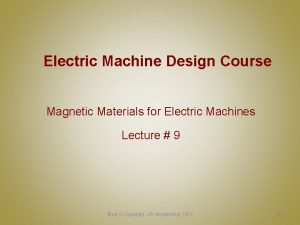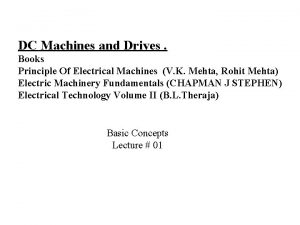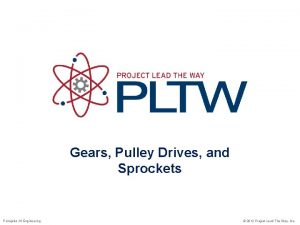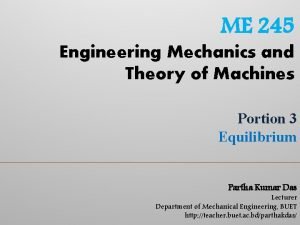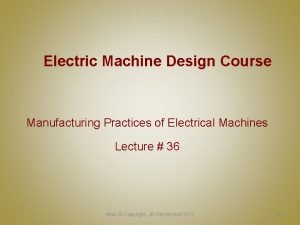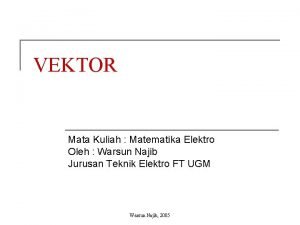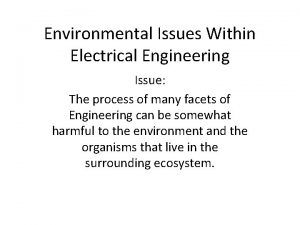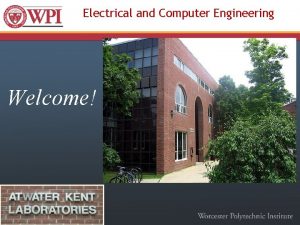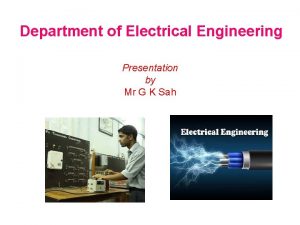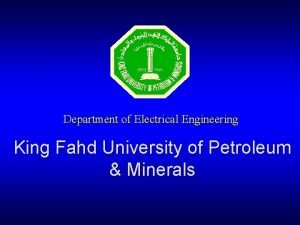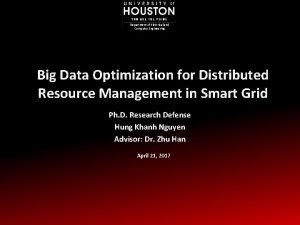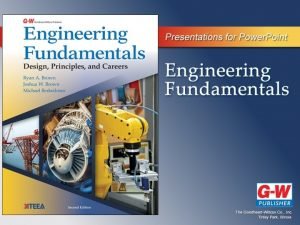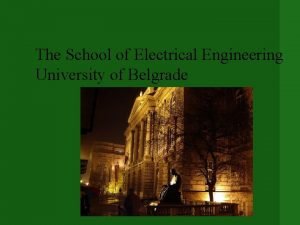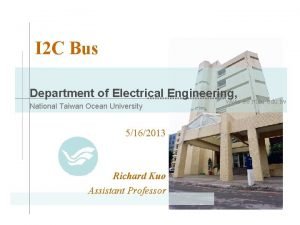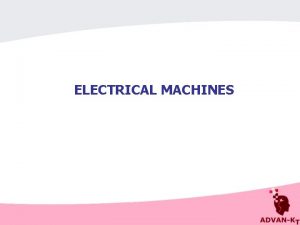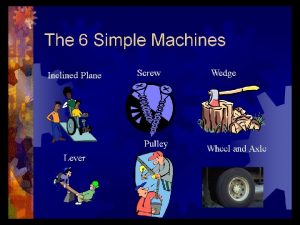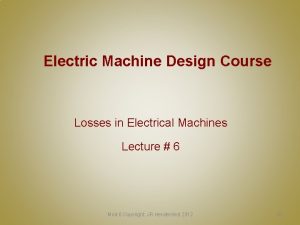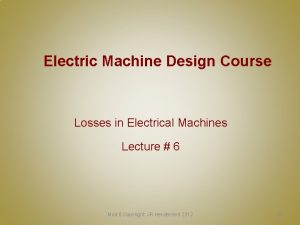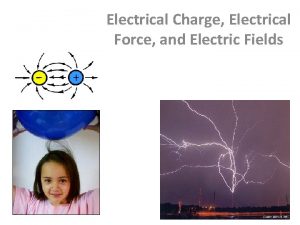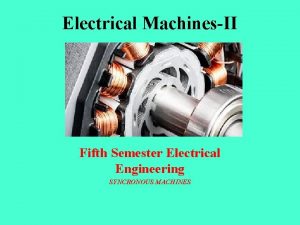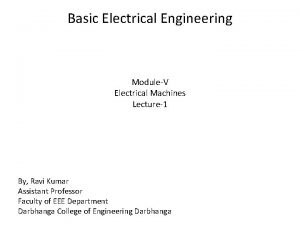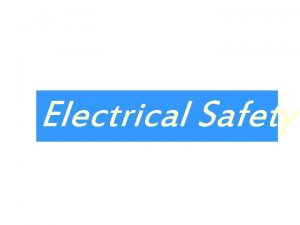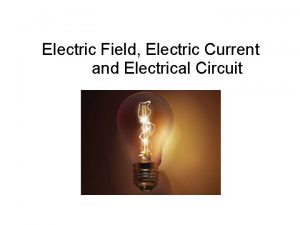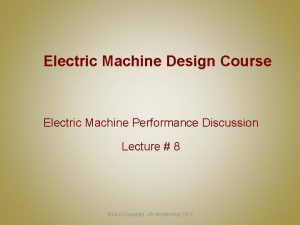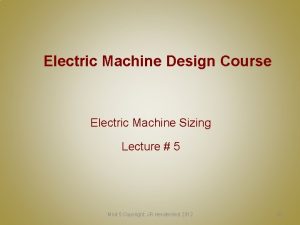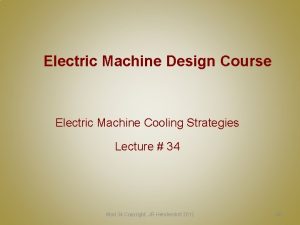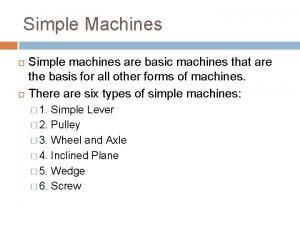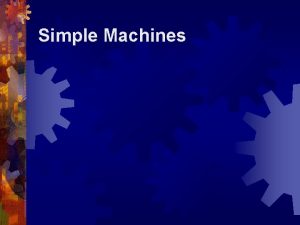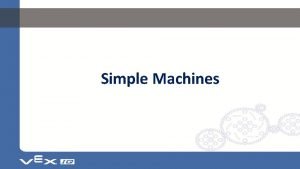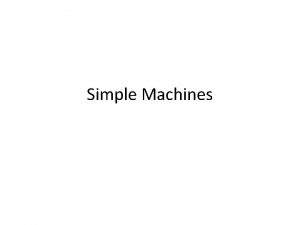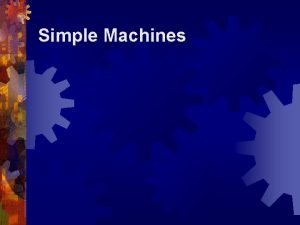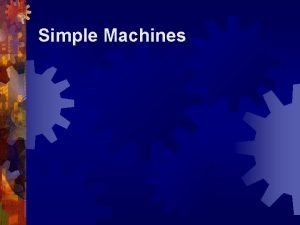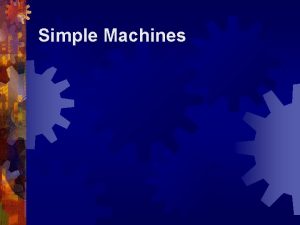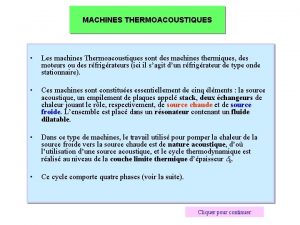Electric Machines In electrical engineering electric machine is

























- Slides: 25

Electric Machines In electrical engineering, electric machine is a general term for • electric motors and • electric generators and • other electromagnetic machines. They are electromechanical energy converters: an electric motor converts electricity to mechanical power while an electric generator converts mechanical power to electricity. The moving parts in a machine can be rotating (rotating machines) or linear (linear machines). Besides motors and generators, a third category often included is transformers, which although they do not have any moving parts are also energy converters, changing the voltage level of an alternating current.

Electric Machines An electric motor is an electrical machine that converts electrical energy into mechanical energy. The reverse of this is the conversion of mechanical energy into electrical energy and is done by an electric generator, and generators and motors have much in common. Most electric motors operate through the interaction between an electric motor's magnetic field and winding currents to generate force. In certain applications, such as in regenerative braking with traction motors in the transportation industry, electric motors can also be used in reverse as generators to convert mechanical energy into electric power.

Electric motors Found in applications as diverse as industrial fans, blowers and pumps, machine tools, household appliances, power tools, and disk drives. Electric motors can be powered by direct current (DC) sources, such as from batteries, motor vehicles or rectifiers, or by alternating current (AC) sources, such as from the power grid, inverters or generators. General-purpose motors with highly standardized dimensions and characteristics provide convenient mechanical power for industrial use. The largest of electric motors are used for ship propulsion, pipeline compression and pumped-storage applications with ratings reaching 100 megawatts. Electric motors may be classified by electric power source type, internal construction, application, type of motion output, and so on.

Energy conversion in motors

Energy conversion in motors

Energy conversion in motors

Electromotors AC Alternating current motors • 3 -phase AC - Induction motor (AC-Asynchronous machine) - AC-Synchronous maschine • Linearmotor • Single phase AC motors: - Condensatormotor - Shaded pole motor (Spaltpolmotor) - Synchronous motor (single phase) - Reluctance motor - (Magnetmotor) • Step motor

Electromotors DC Commutator motors • Direct current motors • Universalmotors (for DC and AC) • Repulsion motor - permament excited DC (Permanent magnet stators) - electric excited DC - Series - Shunt - Compound - Separetely excited - elektronic commutated DC

DC electric motors A DC motor is any of a class of rotary electrical machines that converts direct current electrical energy into mechanical energy. The most common types rely on the forces produced by magnetic fields. Nearly all types of DC motors have some internal mechanism, either electromechanical or electronic, to periodically change the direction of current flow in part of the motor. A DC motor's speed can be controlled over a wide range, using either a variable supply voltage or by changing the strength of current in its field windings. Small DC motors are used in tools, toys, and appliances. The universal motor can operate on direct current but is a lightweight motor used for portable power tools and appliances. Larger DC motors are used in propulsion of electric vehicles, elevator and hoists, or in drives for steel rolling mills. The advent of power electronics has made replacement of DC motors with AC motors possible in many applications.

Brushed DC electric motor The brushed DC electric motor generates torque directly from DC power supplied to the motor by using internal commutation, stationary magnets (permanent or electromagnets), and rotating electrical magnets. Advantages of a brushed DC motor include low initial cost, high reliability, and simple control of motor speed. Disadvantages are high maintenance and low life-span for high intensity uses. Maintenance involves regularly replacing the carbon brushes and springs which carry the electric current, as well as cleaning or replacing the commutator. These components are necessary for transferring electrical power from outside the motor to the spinning wire windings of the rotor inside the motor. Brushes consist of conductors.

Brushed DC electric motor Brushed DC motors are constructed with wound rotors and either wound or permanent-magnet stators. Within the stator is the rotor, which is a winding in an iron core. The rotor is bushed in an axle.

Permament Magnet Brushed DC electric motor Permanent-magnet types have some performance advantages over direct-current, excited, synchronous types, and have become predominant in fractional k. W applications. They are smaller, lighter, more efficient and reliable than other singly-fed electric machines. Originally all large industrial DC motors used wound field or rotor magnets. Permanent magnets have traditionally only been useful on small motors because it was difficult to find a material capable of retaining a high-strength field. Only recently have advances in materials technology allowed the creation of high-intensity permanent magnets, such as neodymium magnets, allowing the development of compact, high-power motors without the extra real-estate of field coils and excitation means. But as these high performance permanent magnets become more applied in electric motor or generator systems, other problems are realized

Permament Magnet Brushed DC motor The field coils have traditionally existed in four basic formats: separately excited (sepex), series-wound, shunt-wound, and a combination of the latter two; compound-wound. In a series wound motor, the field coils are connected electrically in series with the armature coils (via the brushes). In a shunt wound motor, the field coils are connected in parallel, or "shunted" to the armature coils. In a separately excited (sepex) motor the field coils are supplied from an independent source, such as a motor-generator and the field current is unaffected by changes in the armature current. The sepex system was sometimes used in DC traction motors to facilitate control of wheelslip.

Permament Magnet Brushed DC motor

Permament Magnet Brushed DC motor The field coils have traditionally existed in four basic formats: • separately excited (sepex), • series-wound, • shunt-wound, • and a combination of the latter two; compound-wound. In a series wound motor, the field coils are connected electrically in series with the armature coils (via the brushes). In a shunt wound motor, the field coils are connected in parallel, or "shunted" to the armature coils. In a separately excited (sepex) motor the field coils are supplied from an independent source, such as a motor-generator and the field current is unaffected by changes in the armature current. The sepex system was sometimes used in DC traction motors to facilitate control of wheelslip.

Permament Magnet Brushed DC motor The field coils have traditionally existed in four basic formats: • separately excited (sepex), • series-wound, • shunt-wound, • and a combination of the latter two; compound-wound. By Haade - Own work, CC BY-SA 3. 0, https: //commons. wikimedia. org/w/index. php? curid=3338954

Series-wound (Univeral) Brushed DC motor The universal motor is so named because it is a type of electric motor that can operate on AC or DC power. It is a commutated serieswound motor where the stator's field coils are connected in series with the rotor windings through a commutator.

Series-wound (Univeral) Brushed DC motor It is often referred to as an AC series motor. The universal motor is very similar to a DC series motor in construction, but is modified slightly to allow the motor to operate properly on AC power. This type of electric motor can operate well on AC because the current in both the field coils and the armature (and the resultant magnetic fields) will alternate (reverse polarity) synchronously with the supply. Hence the resulting mechanical force will occur in a consistent direction of rotation, independent of the direction of applied voltage, but determined by the commutator and polarity of the field coils.

Series-wound (Univeral) Brushed DC motor Universal motors have high starting torque, can run at high speed, and are lightweight and compact. They are commonly used in portable power tools and equipment, as well as many household appliances. They're also relatively easy to control, electromechanically using tapped coils, or electronically. However, the commutator has brushes that wear, so they are much less often used for equipment that is in continuous use. In addition, partly because of the commutator, universal motors are typically very noisy, both acoustically and electromagnetically.

Series-wound (Univeral) Brushed DC motor

Series-wound (Univeral) Brushed DC motor

Series-wound (Univeral) Brushed DC motor

Paralell-wound (Shunt) Brushed DC motor In case of a shunt motor, the field coils are connected in parallel, or "shunted" to the armature coils. The AC mode is not possible, because of the great inductivitat of the field winding. The PM of bigger shunt motors are load-independent.

Paralell-wound (Shunt) Brushed DC motor By breaking the excitation circuit the motor breaks down!

Paralell-wound (Shunt) Brushed DC motor Shunt motors can also be used as generators, (also for breaking in vehicles) when an external voltage source, or remaining magnetism provides excitation in the begining of the operation. With increasing excitation or RPM increases the inducted voltage as well. This self inducted voltage is the counter EMF, that works against the connected voltage, and results the constant RPM of the motor.
 Magnetic materials used in electrical machines
Magnetic materials used in electrical machines Principles of electrical machines vk mehta
Principles of electrical machines vk mehta Principle of operation of synchronous motor
Principle of operation of synchronous motor Electric machines
Electric machines Gears and pulley
Gears and pulley Improperly constrained
Improperly constrained Electric machine design training
Electric machine design training Pengurangan vektor
Pengurangan vektor Gwu electrical engineering
Gwu electrical engineering Tel aviv university electrical engineering
Tel aviv university electrical engineering Northwestern electrical engineering
Northwestern electrical engineering Klipsch school of electrical and computer engineering
Klipsch school of electrical and computer engineering Electrical engineering department
Electrical engineering department Umd ece faculty
Umd ece faculty Purpose of estimating and costing in electrical engineering
Purpose of estimating and costing in electrical engineering Electrical engineering environmental issues
Electrical engineering environmental issues Wpi bme tracking sheet
Wpi bme tracking sheet Electrical engineering presentation
Electrical engineering presentation Electrical engineering kfupm
Electrical engineering kfupm Big data in electrical engineering
Big data in electrical engineering Define electrical engineering
Define electrical engineering Basic electrical engineering kulshreshtha
Basic electrical engineering kulshreshtha University of belgrade school of electrical engineering
University of belgrade school of electrical engineering Electrical engineering notation
Electrical engineering notation Bus electrical engineering
Bus electrical engineering Electrical engineering definition
Electrical engineering definition
